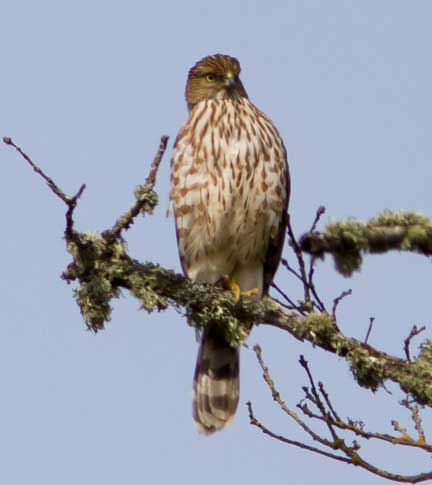 |
Predators like this Cooper's Hawk inspire aggressive behavior.
Photo © 2011 by Jeff Young. |
The Nature of Cedar Mill
Hormones
by Lauretta Young
Unlike humans, most species of animals breed at defined times. (Humans do have some periods of greater fertility, but as we know from scientific studies of the body temperature method to assess peak fertility in females, many factors such as stress "mess up" the predictability of such measures.) For birds and many other animals there is truly a period of the year that is called "breeding season" and most of the science reflects that this period of breeding behaviors are induced by hormonal changes. These hormones tend to get released due to daylight length changes and possibly other cues such as body weight, which is a marker for how much food is present in the local environment.
Hormones also cause the changes in bird feather coloration we see in the bright spring plumages of many perching birds. Some of these birds have spent the winter in southern climates, eating and preparing their bodies to go through the arduous energy expense of laying eggs and feeding the chicks. After they fly back to the nesting sites, many of them go through a molt where they lose their old tattered dingy feathers for a new set of "Easter best" breeding attire.
These same hormones cause the male birds to sing loudly to advertise not only their fitness as an attractive mate, but to signal where their prime nesting territory is. During this time of year some songbirds also get very aggressive, especially to birds of the same species, or to birds who pose a threat (such as the bird-eating Cooper's or Sharp Shinned Hawks—who are also feeding nestlings!).
Robins in particular in our area—and Northern Cardinals in the eastern part of the US—tend to get particularly feisty if they believe they see another male robin. And since they are urban birds that nest close to houses and other buildings, they "see" other robins in windows in which their own reflection becomes the "enemy". Many of my neighbors call every year (since I am the "bird lady") to ask, "Why does that robin start flinging itself at my window—usually at 5 AM?" And then of course they want to know what to do about it. Many people are concerned about the birds and whether they might get hurt but also concerned about how noisy this behavior is to the inside house occupants.
Research from ornithologists on this topic indicates that most birds don't hurt themselves. Nevertheless we all know of robins that have gotten concussions and either died or are done in by a roaming outdoor cat while they are stunned. In certain years when the concentration of robins is high, more have to nest near houses, so this behavior varies from year to year, depending on how densely packed the robins are while competing for nesting sites.
The research is all over the map about what to do. One can read web sites that recommend draping plastic snakes over outside windows (isn't that attractive?) and other sites indicate that this is not effective at all. Most authorities recommend not doing much since if one covers one window the robin, as it flies around, will find another one or a shiny car surface. So if this bird is waking you up—certainly drape something over the OUTSIDE of the window. Simply pulling the inside blinds or drapes down does not appear to change the reflection in the window—which is what Mr. Robin's hormones perceive as a threat. So drape whatever seems useful and least ugly to you—maybe even a windsock that flutters in the wind, breaking up the reflection—but also some kind of opaque material that you have around works too.
Robins in our area tend to have two breeding seasons and most produce two batches of chicks—so you may have to repeat this window covering later on. It also might be a great excuse to not clean your windows, but most of us are so hungry for the sunlight to come in that this may not be an attractive option.
Lauretta Young is a retired physician who currently teaches at PSU and OHSU in mind-body medicine. She also leads bird tours in Cedar Mill and beyond—check out her web site for more information: www.portlandbirdwatching.com. Her husband, Jeff enjoys sharing his bird photography so check out www.flickr.com/photos/youngbirders for more photos!
|
